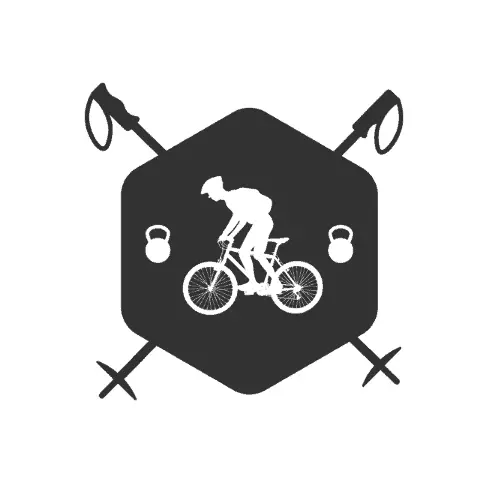Want to learn more about park skis? You’ve come to the right place. In this blog, I dive deep into park skis and highlight their defining characteristics.
Whether you’re choosing a new pair of skis or if you just want to nerd out on skis stats, you’re in the right place.
By the end of this article, you’ll fully understand park skis and be able to talk gear with a park skier easily.
This is one article in my six-part series that explains every category of alpine ski. You can check out the rest of the articles here.
Table of Contents
Disclaimer: This page may contain affiliate links.
What Are Park Skis?
Park skis are a type of ski explicitly designed for skiing in the terrain park. They are made to hit jumps, rails, boxes, and spin in all directions.
Park skis are short, have a narrower waist width, a symmetrical shape, and have center-mounted bindings. Park skis are also very durable. They need to withstand the abuse of landing on metal features day in and day out.
Regarding dimensions, park skis have an 80mm – 100mm waist width. Their turning radius is between 14m and 21m, depending on the model and length of the ski. Park skis have camber underfoot with minimal rocker. This type is typically symmetrical with tips and tails that are slightly wider than the middle of the ski.
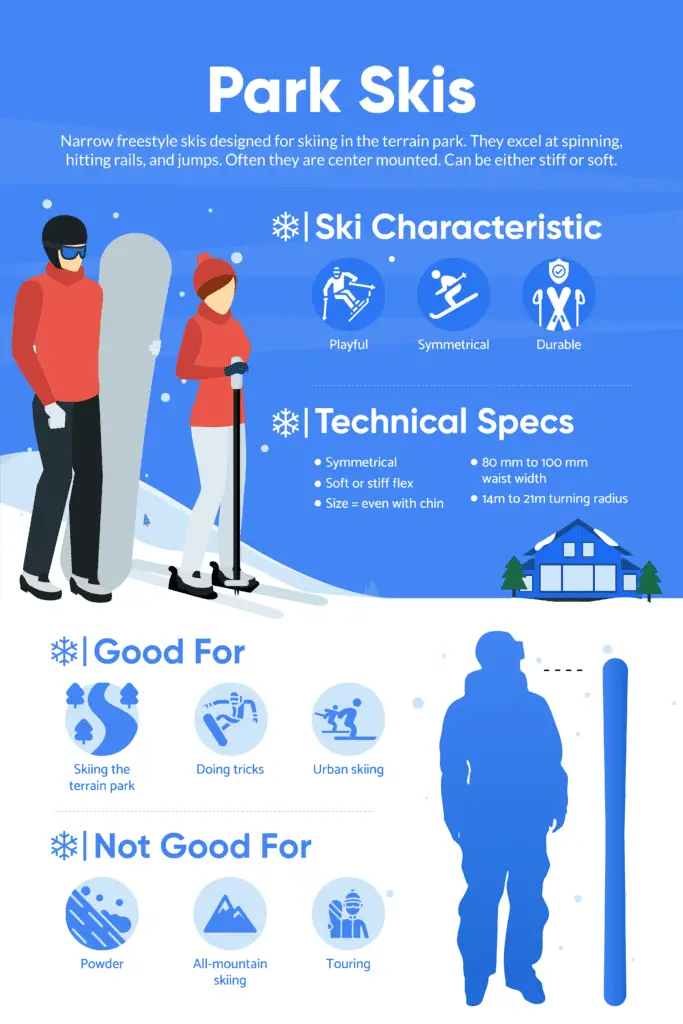
How are Park Skis Different From Other Skis?
Park skis are different from other skis because they have to perform well in the snow and in the air.
Park skis are shorter than other skis to make it easier to spin rotations. For instance, shorter skis make it easier to do a 360 off a jump.
They also have a narrower waist width because they are designed for skiing groomed snow. Hence, they don’t need the extra soft snow floatation a wider waist width provides.
Further, park skis are often symmetrical to make it easier to ski and land backwards. Park skiing is all about doing tricks, and skiing backwards opens up more trick options. To complement the symmetrical shape, park skis usually have center-mounted bindings.
(Love Skiing? Keep yourself in ski shape with these workouts.)
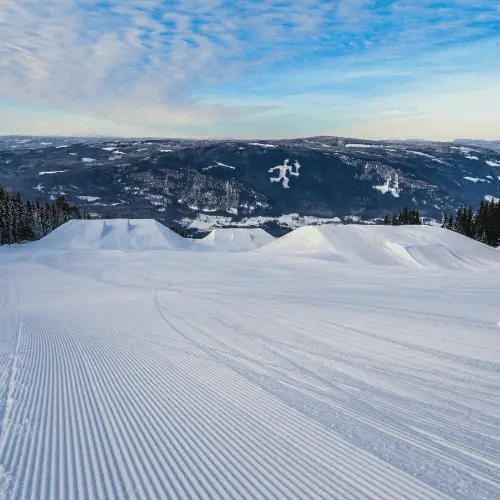
Technical Information
Construction
Park skis are often made fully out of wood with some carbon or composite stringers to create pop in the ski. It is rare to find a park ski that had metal in it.
Flex
Park skis are either very flexy or quite stiff. The flexy skis make buttering and other jib tricks easier. The stiffer skis make it easier to land large airs. They offer more support if you don’t land perfectly. I’d recommend choosing a ski somewhere in the middle between stiff and soft unless you prefer one of these two types of skiing.
Shape
Park skis have a narrow waist width with slightly larger tips and tails. This gives the ski a side cut that allows it to carve. Often these skis are symmetrical, meaning the tip and tail are the exact same size. If they are not symmetrical, the size difference between the tip and tail is minuscule.
Camber Profile
Park skis have camber underfoot with minimal rocker in the tips and tails. The camber helps the ski carve off of the lip of a jump to start a spin. The camber also helps the ski grip the rail, opening up options to spin while on the rail.
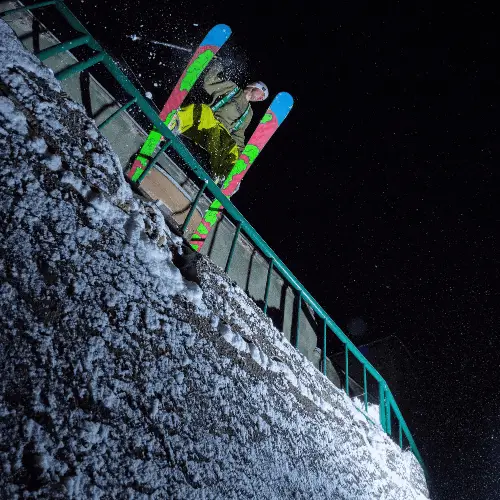
What Size Park Ski Do You Need
Choose a park ski in a length that is shorter than your all-mountain ski. As a rule of thumb, go with a ski that is even with your chin. Park skis are designed to spin, flip, and hit airs. A shorter length makes it easier to maneuver the ski.
Further, these skis are fully cambered and have a long effective edge. Which means they will ski very true to size. If you’re having trouble choosing the right size, check out this free ski size calculator.
Are Park Skis Good in Powder
No, park skis are not good in powder. Their narrow waist width and shorter length does not float well in deep fresh snow. But this is not what they are designed for.
If you’re looking for a good ski in powder, check out a powder ski. If you want to ski the park and ski some powder, I recommend a medium-waist-width freeride ski. Something between 100mm and 108mm is the sweet spot. I love the Faction Prodigy 3.0 for this. That’s the daily driver in my quiver.
Are Park Skis Good for Carving
Park skis are okay at carving but not nearly as good as all-mountain or race skis.
Park skis are fully cambered and can carve. The need to carve because carving off of the lip of a jump is one way to start the rotation of a spin or cork trick. However, since they are short and mounted in the center, they cannot carve as well as all-mountain or race skis.
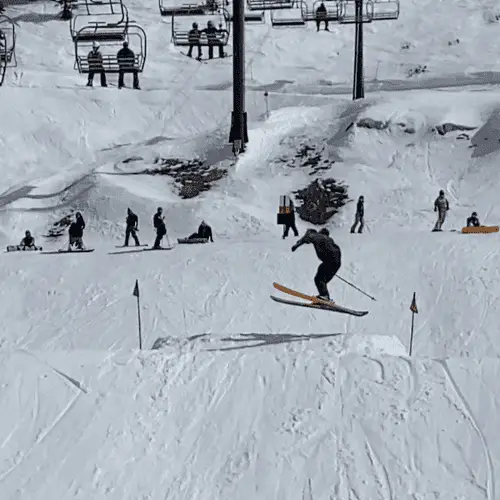
Park Ski Recommendations
The Volkl Revolt 87 is a stiff park ski made for going massive and stomping. This ski appears at every X Games slopestyle competition and is a staple in the park skiing world. Whether you’re just getting into park skiing or a serious competitor, the Revolt 87 will always have your back.
The Faction Prodigy 2.0 is a tremendous daily park ski that won’t punish you when you leave the park. I use its bigger brother, the 3.0, as my daily driver, and it handles the park and all-mountain with ease. The Prodigy series is a nice balance between a soft jib noodle and a stiff competition stick. It’s something the average skier will love.
The Line Blend is a staple park ski. I grew up watching this ski make its rounds in the Line Traveling Circus videos. When I was a ski instructor at my local mountain, I spent some time on the blends and realized why they are in the Traveling Circus videos. They are playful! These skis are soft and love to butter, press, and pop everything in sight. If that’s what you’re into, look no further.
How to Choose Park Skis in the Shop
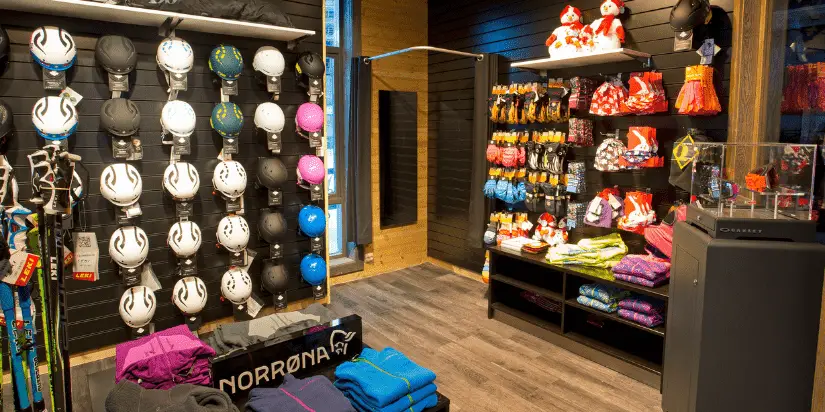
Now let’s talk about taking this knowledge to the ski shop.
If you’re looking to buy or rent a pair of skis, here’s what I recommend. Start with reading the section about what park skis are. Make sure you’re not better off with an all-mountain or freeride ski.
Now read the section about sizing. Get a rough idea of your size.
Next, think about how you like to ski. Do you like to butter and play or do you like to go big? If you love buttering go with a soft flex. If you want to send, get something stiff.
Now head over to your local shop or e-commerce store. You can narrow down the park skis based on waist width right away. Remember less than 100mm. Now, look at the skis they have in your size.
Then it’s time to read the product description and talk to the employees. Ask about the ski’s characteristics. Is it soft or stiff? Does it prefer rails or jumps?
With this information, you’ll be more prepared than 75% of people that walk into the ski shop. I always recommend chatting with support or an employee to learn the subtle nuances of each ski.
I hope this post clearly explains park skis. Please reach out if you have any questions or suggestions on what I should add to the article.
